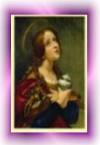In 1695, Francesco entered the Conventual Franciscans in his town when he was just 14 years old. He took the names of Saints Francis and Anthony, thus expressing his fervent desire to follow their example by consecrating himself to an evangelical and apostolic life. Professing his vows in 1696, the young Friar Francis Anthony completed his liberal arts studies and followed with his philosophical studies in the seminaries of his religious province. Thereafter, he began theological studies in Agnone and continued them in the General Study Center at Assisi near the tomb of St. Francis. It was there that Francis Anthony was ordained to the priesthood in 1705. Then, in 1707, he completed his theological studies.
After his ordination 10 years later, he taught philosophy to younger friars, served as guardian of his friary, and later became provincial minister. When his term of office ended, Francesco became master of novices and finally pastor in his hometown at the convent of Lucera. Francis Anthony progressed in a life of union with God, patterning himself on the Lord through religious consecration and the priestly charism.
From 1707 until his death, Francis Anthony continued to live at Lucera for thirty-five years, always giving splendid witness to the gospel life and zealous pastoral ministry. For this reason he was admired by the faithful of Lucera and all of Daunia and Molise.
In 1709 at the College of Saint Bonaventure in Rome, Francis Anthony received a graduate degree in theology and from that time on Father Fasani was known to all as “Padre Maestro” (“Father Master”), a title which is still attributed to him today in Lucera. He exercised the offices of local superior and minister provincial with charity and wisdom, demonstrating that he was and effective animator of the religious life of the brethren. He was also a mystic, known for his deep prayer life and supernatural gifts.
The spiritual life of Francis Anthony was characterized by those virtues that made him like his Seraphic Father, Saint Francis of Assisi. In fact, it was said in Lucera: “Whoever wants to see how St. Francis looked while he was alive should come to see Padre Maestro.” In imitation of St. Francis, Francis Anthony built his religious life on the basis of a generous participation in the mysteries of Christ through the most faithful practice of perfect charity. In his constant prayers, inflamed with love, he called out to God, saying to Him: “O Highest Love, Immense Love, Eternal Love, Infinite Love.”
The poor, the sick, and the imprisoned held a privileged place in his pastoral activities. Motivated by his ideal of gospel charity (“We must be charitable.”), he loved to pray with the poor and for them. Every day he personally distributed to the poor the alms of his religious community and very often he gave them as well gifts and special goods gathered from benefactors.
Francis Anthony dedicated himself with zeal-especially the administration of the sacrament of Penance and the celebration of the Holy Eucharist. He was a sought-after confessor and preacher. “He heard the confession of every type of person,” asserted a witness, “with the greatest patience and kindness on his face”. He was charitable and welcoming to all, giving as his reason the hope of being able one day to say to the Lord: “I was indulgent, I don’t deny it but it was You who taught me to be so.” One witness at the canonical hearings regarding Francesco’s holiness testified, “In his preaching he spoke in a familiar way, filled as he was with the love of God and neighbor; fired by the Spirit, he made use of the words and deed of Holy Scripture, stirring his listeners and moving them to do penance.”
On November 29, 1742 in Lucera, Foggia, Puglia, Italy, Francis Anthony died and returned his soul to God in the friary of the city where he was born and where, for thirty-five years, he showed himself a faithful witness to Christ. He was buried at the church of San Francesco di Lucera, where his tomb became a place of veneration and prayer. Upon the news of his death, children could be heard running through the streets shouting, “The saint is dead! The saint is dead!”

